Geomicrobiology
Since the emergence of life, tiny microorganisms have dominated for over three billion years, but their activities have significantly changed the Earth's environment. Traces of these activities are recorded in carbonate minerals, phosphate minerals, iron oxides, manganese oxides, and other minerals in the geological sucsessions. In our laboratory, we aim to elucidate the evolutionary history of life and the Earth's environment from sediments and sedimentary rocks by using cutting-edge microbiological techniques in addition to geological and geochemical methods. Below is a brief introduction of our recent research results.

A summary of the Earth history.
The origin of travertine formed at the gas-liquid interface was elucidated
[Key points of this research]
- It was found that in hot springs that form travertine, more active precipitation occurs on the water surface than on the bubble surfaces.
- It is thought that the adhesion and growth of calcium carbonate formed elsewhere is predominant on the bubble surfaces.


Figure: (Left) Coated bubbles seen in the travertine used in the hotel's walls, (right) Coated bubbles forming in Nagayu Onsen.
Paper information: Shiraishi F., Akimoto T., Tomioka N., Motai S., Takahashi Y. (2023) Formation processes of paper-thin raft and coated bubble: Calcium carbonate deposition at gas-water interface. Sedimentary Geology 456, 106514.
The characteristics and origin of microdolomites found in methane hydrate were elucidated
[Key points of this research]
- Due to differences in their origins, it was found that microdolomites are composed of a combination of several types of cores and external cements.
- It is thought that the formation of microdolomites with black cores involves the extracellular polymeric substances of microorganisms.
[Overview]
Microdolomites of approximately 30-150 μm in diameter were recently discovered in methane hydrates excavated from gas chimneys in the Japan Sea. Microbial extracellular polymeric substances (EPS) were presumed to play an important role in their formation, but direct evidence for this had not been found.Our research group selected two typical microdolomite particles and observed thin-foil sections prepared by focused ion beam (FIB) processing using scanning transmission X-ray microscopy (STXM) and transmission electron microscopy (TEM). The particles with a black core exhibited morphological and chemical characteristics indicative of the presence of EPS, suggesting that dolomite formed on microbial EPS via an amorphous precursor (ACC). On the other hand, particles with a cloudy core exhibited characteristics resembling the accumulation of dolomite nanocrystals on an oil film, suggesting that they formed due to a rapid increase in saturation in the interstices of actively growing hydrates. The characteristics and origin of these microdolomite particles provide important insights into the origin of dolomite found in other environments and time periods.
This research was conducted as part of the master's thesis research of Mr. Takayuki Akimoto (graduated in 2021), and the results were published in the scientific journal "Frontiers in Earth Science."


Figure: (Left) Mr. Akimoto operating the STXM installed at the High Energy Accelerator Research Organization, (right) STXM analysis results of a microdolomite with black nucleus.
The decomposition process of microbial carbonates was elucidated
[Key points of this research]- It has been found that environmental changes are causing microbial carbonate decomposition in Brazilian lagoons.
- It is possible that stromatolites and other rochs were being decomposed by microorganisms even before the appearance of multicellular animals.
While there has been much research into the formation process of microbial carbonates such as stromatolites, there has been very little research into their decomposition process.
Our research group therefore focused on microbial carbonates found in the Brazilian lagoon (Lagoa Vermelha). This is famous as the location where microbially-originated dolomite has been reported, but it also contains stromatolites and microbial mats, and has been exposed to major environmental changes. Examining these revealed that carbonate deposits once formed by microorganisms are being decomposed not only by the feeding activity of multicellular animals, but also by microbial metabolism. These results indicate that carbonate deposits can begin to decompose when the microbial community composition changes due to environmental changes, providing important insights not only into the interpretation of past carbonate rocks, but also into the preservation of modern-day stromatolites.
The results of this study were published in the scientific journal "Journal of Sedimentary Research."
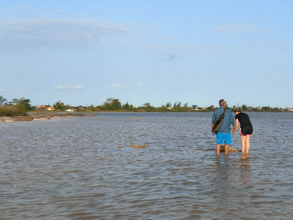
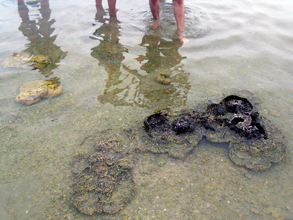
Figure: (Left) Survey at Lagoa Vermelha, (Right) Stromatolites in the process of decomposition.
Paper information: Shiraishi F., Hanzawa Y., Asada J., Cury L.F., Bahniuk A.M. (2023) Decompositional processes of microbial carbonates in Lagoa Vermelha, Brazil. Journal of Sedimentary Research 93, 202-211.The conditions for manganese oxidation by oxygenic photosynthesis were elucidated
[Key points of this research]
- Due low pH of Onneto Yunotaki Falls in Hokkaido, manganese oxidation does not occur through photosynthesis by green algae.
- The pH of the Precambrian ocean was also low, so the effect of photosynthesis on manganese oxide formation may have been limited.
[Overview]
Our research at Sanbe Hot Springs has revealed that benthic oxygenic photosynthetic microorganisms may be involved in the formation of manganese oxides. However, the conditions under which such a phenomenon occurs remained unknown.
Our research group therefore investigated manganese oxides covered with green algae found at Onneto Yunotaki Falls in Hokkaido. Our results revealed that the low pH of the hot spring water makes the manganese oxidation process by oxygenic photosynthesis undetectable, and that oxidation by manganese-oxidizing bacteria is likely dominant. These results provide important information for interpreting the manganese oxidation process in the Precambrian ocean, which also had a low pH.
This research was conducted as the master's thesis by Mr. Ryoji Chihara (graduated in 2014) and the graduation thesis by Risa Tanimoto (graduated in 2018), and was published in the scientific journal "Island Arc."
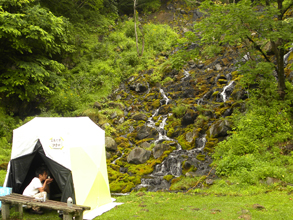
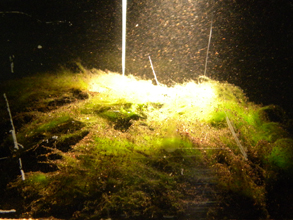
Figure: (Left) Survey at Onneto Yunotaki Falls, (Right) Microelectrode measurements near the surface of manganese oxide.
Paper information: Shiraishi F., Chihara R., Tanimoto R., Tanaka K., Takahashi Y. (2022) Microbial influences on manganese deposit formation at Yunotaki Fall, Japan. Island Arc 31, e12448.
The influence of microorganisms on tropical tufa formation was elucidated
[Key points of this research]
- It has been found that tropical tufa has characteristics that differ from those in cool and temperate zones.
- It is possible that microbial metabolism other than photosynthesis plays an important role in carbonate precipitation.
[Overview]
Tufas are carbonate deposits formed in freshwater environments and are attracting attention as "living fossils" of microbialites and as paleoclimate records. Our previous research has revealed that tufas with stromatolite and thrombolite textures are formed by photosynthesis, and that these differences in texture are produced by cyanobacterial communities with different EPS properties. However, these results were obtained from tufas distributed in both cool and temperate zones, and it was unclear whether they also apply to tropical tufas, where seasonal temperature fluctuations are small.
Our research group therefore investigated tropical tufas found in Mato Grosso do Sul, Brazil, and revealed that carbonate precipitation processes, in addition to photosynthesis, contribute to the formation of tufas, that stromatolite-like laminations are weakly developed, and that conical surface protrusions are developed. These results provide important information for interpreting microbialite textures and paleoclimate records.
The results of this study were published in the scientific journal "Sedimentary Geology."
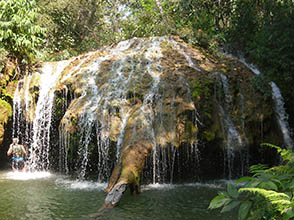
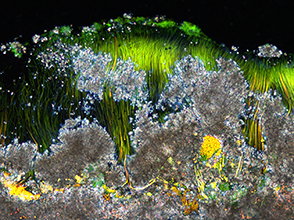
Figure: (Left) Tufa in Brazil where the survey was conducted, (right) Cyanobacteria living on the surface of the tufa.
Paper information: Shiraishi F., Hanzawa Y., Asada J., Cury L.F., Bahniuk A.M. (2022) Microbial influences on tufa deposition in the tropical climate. Sedimentary Geology 427, 106045.
General rules regarding the formation process and mineral composition of travertine were elucidated
[Key points of this research]- In addition to abiotic processes, microbial metabolism and its products also play an important role in travertine formation.
- The mineral composition of travertine was found to be most strongly influenced by the Mg2+ and SO42- concentrations in the hot spring water.
Travertine, a carbonate deposit formed in hot springs, can provide important information for understanding the genesis of ancient stromatolites and microbial oil reservoirs. Our research at Nagayu Hot Spring in Oita Prefecture and Futamata Hot Spring in Hokkaido has already revealed the relationship between travertine formation processes and precipitation textures, but its universality was unclear. Furthermore, while travertine is primarily composed of calcite and aragonite, the causes of these mineral differences were not well understood.
Our research group comprehensively collected data from travertines found in eight hot springs in Japan, including Nagayu Hot Springs and Futamata Hot Spring, and revealed that while abiotic processes dominate overall, biotic processes dominate in some locations. We also found that higher concentrations of magnesium and sulfate ions in hot spring water are more likely to form aragonite. These results are expected to provide essential information for interpreting oil reservoirs with similar characteristics and carbonate rocks found in the Archean and Proterozoic eras.
This research was conducted as part of the graduation and master's theses of Mr. Yuki Eno, Ms. Yuki Nakamura (graduated in 2015), and Ms. Asayo Morikawa (graduated in 2017), and the results were published in the scientific journal "Sedimentology." This research was also included in the top 10 most cited papers in Sedimentology from 2022 to 2023.
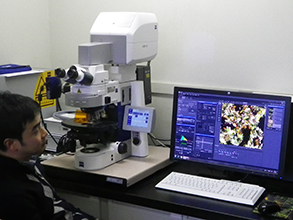
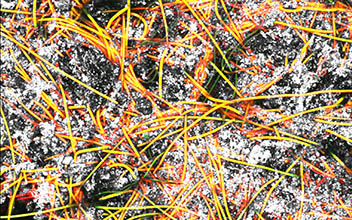
Figure: (Left) Observation scene using a confocal laser scanning microscope and (right) observation results of the travertine surface.
Paper information: Shiraishi F., Hanzawa Y., Nakamura Y., Eno Y., Morikawa A., de Mattos R.F., Asada J., Cury L.F., Bahniuk A.M. (2022) Abiotic and biotic processes controlling travertine deposition: Insights from eight hot springs in Japan. Sedimentology 69, 592-623.
The causes of differences in cyanobacterial calcification styles were elucidated
[Key points of this research]
- It was found that the calcification styles of cyanobacteria is greatly influenced by the physical properties of the cell surface.
- It is possible that the increase and decrease in microbialites and their structural changes were controlled by the surface properties of microbial cells.
[Overview]
Cyanobacteria, oxygenic photosynthetic bacteria, form microbialites such as stromatolites and thrombolites depending on their calcification style. It was known that the presence or absence of calcification is controlled by the chemical properties of EPS secreted by cyanobacteria, but the reasons for the differences in the calcification style were not well understood.
Our research group analyzed artificially calcified cyanobacteria using scanning transmission X-ray microscopy (STXM) and other techniques, and elucidated that the physical properties of the cell surface have a significant impact on the calcification style. It is possible that the increase and decrease in microbialites and their fabric changes throughout Earth's history are controlled by the surface properties of microbial cells, which may provide new insights into the evolution of life and environmental changes.
This research was conducted as the graduation and master's thesis research of Mr. Takeru Omori (graduate in 2018), and the results were published in the scientific journal "Geochimica et Cosmochimica Acta."
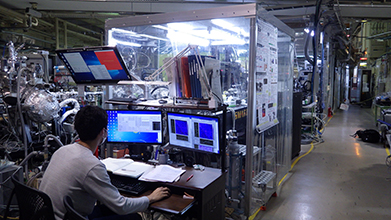
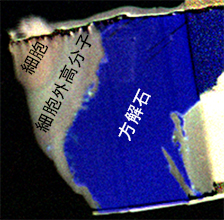
Discovered Japan's first Fisher Ridge travertine
[Key points of this research]
- The first Fisher Ridge type travertine was discovered in Japan at Futamata Hot Spring in Hokkaido.
- The travertine at Futamata Hot Spring may have been formed from approximately 20,000 years ago.
[Overview]
Travertine, a carbonate deposit formed by hot springs, comes in a variety of forms, but dome-shaped travertines are most common in Japan. Our research group discovered the first Fisher Ridge-type travertine in Japan, at Futamata Hot Springs in Hokkaido. This travertine is old, having formed between approximately 20,000 and 7,000 years ago, and has been lithfied by significant diagenesis. On the other hand, dome-shaped travertine is thought to have developed after approximately 7,000 years ago. These results are expected to provide essential information for interpreting the diagenetic processes of travertine and similar sedimentary rocks.
This research was conducted as the graduation and master's thesis of
Ms. Morikawa Asayo (graduated in 2017), and the results were
published in the scientific journal "Sedimentary Geology."

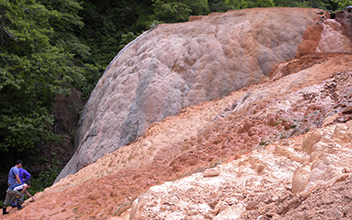
Figure: (Left) Fisher Ridge-type travertine formed in the past, and (right) dome-type travertine that continued to form until recently, both of which can be seen at Futamata Hot Spring.
The influence of microorganisms on manganese oxide formation was elucidated
[Key points of this research]
- It has been found that benthic oxygenic photosynthetic microorganisms efficiently oxidize manganese.
- It is possible that extensive manganese oxidation occurred in shallow oceans after the snowball Earth approximately 2.4 billion years ago.
[Overview]
Extensive manganese deposits formed after the so-called Huronian glaciation, approximately 2.4 billion years ago, are thought to be evidence of the mass emergence of oxygenic photosynthetic microorganisms. However, the manganese oxidation process through oxygenic photosynthesis involved in this process was not well understood.
Based on research into manganese crusts found in Sanbe Hot Springs, Shimane Prefecture, our research group has elucidated that the oxygen released by benthic oxygenic photosynthetic microorganisms efficiently oxidizes manganese. It is possible that lextensive manganese oxidation occurred in shallow waters, and it is expected that this will provide new insights into the formation of Precambrian sedimentary manganese deposits.
This research was conducted as the graduation and master's theses of Mr. Ryoji Chihara (graduate in 2014) and Mr. Yuya Matsumura (graduate in 2017), and the results were published in the scientific journal "Geochimica et Cosmochimica Acta."

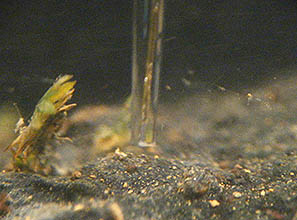
Figure: (Left) The manganese crust under study, (Right) Measurement of Mn(II) concentration near the surface of the manganese crust using a microelectrode.
Phosphate stromatolites are the evidence of unique ocean conditions after the snowball Earth
[Key points of this research]
- It was found that when oceanic phosphorus concentrations are high, phosphate stromatolites are formed through photosynthesis.
- It is possible that oceanic phosphorus concentrations were very high after the snowball Earth.
[Overview]
Stromatolites are laminated deposits formed by benthic microbial communities. While most are composed of carbonate minerals, stromatolites composed of phosphate minerals can be seen after the Late Neoproterozoic glacial period (approximately 630 million years ago), which is thought to have been the snowball Earth.
Based on research into Neoproterozoic phosphate stromatolites in Brazil, our research group has clarified that phosphate stromatolites are formed by photosynthesis when ocean phosphorus concentrations are approximately 5 μmol/L or higher. This suggests that phosphorus concentrations may have been extremely high even in shallow seas, and it is expected that new knowledge will be gained about continental weathering and ocean circulation after the snowball Earth.
This research was conducted as the graduation and master's thesis of Ms. Saki Onishi (graduated in 2016), and the results were published in the scientific journal "Sedimentary Geology."
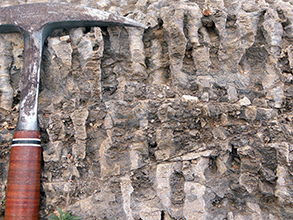
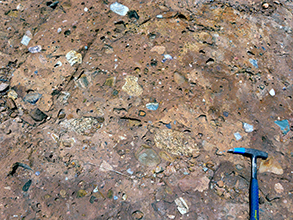
Figure: (Left) Phosphate stromatolite studied, (right) Glacial deposits thought to have been deposited during the snowball Earth.
The origin of travertine's microstructure was elucidated
[Key points of this research]
- It has been found that microorganisms such as cyanobacteria make travertine into porous.
- This finding may lead to an understanding of the origin of the microstructures seen in microbial oil reservoirs.
[Overview]
Carbonate deposits formed in hot springs are called travertines. Understanding the relative influence of biotic and abiotic processes in the formation of travertine microfabrics is important for understanding the genesis of ancient stromatolites and microbial oil reservoirs.
Based on a study of travertines found in the hot springs of Nagayu Hot Spring, Oita Prefecture, our research group has clarified that a porous texture is formed when microbial processes are dominant, while a dense texture is formed when abiotic processes are dominant. These results are expected to provide essential information for interpreting ancient travertines and similar sedimentary rocks.

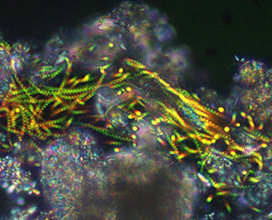
Figure. (Left) Travertine found in the Nagayu Hot Spring. (Right) Cyanobacteria living on the surface of travertine.
The conditions under which microorganisms contribute to the formation of iron oxides were elucidated
[Key points of this research]
- It was found that when oxygen concentrations were high, the contribution of microorganisms to the iron oxidation process was small.
- This suggests that the formation process of banded iron fomrations may have been different before and after the Great Oxidation Event.
[Overview]
Banded iron formations, which contain large amounts of iron oxide, are often found in Precambrian strata and record important information for understanding how the redox state of the Earth's environment has changed over time. However, many details about their formation process remain unknown.
Based on studies of iron oxides occurring in hot springs, our research group has clarified that the contribution of microbial iron oxidation processes (direct oxidation by iron-oxidizing bacteria and indirect oxidation by cyanobacteria) is small unless oxygen concentrations are below approximately 50 μmol/L. The increase in ocean oxygen concentrations associated with the Great Oxidation Event may have shifted the dominant iron oxidation process from microbial to inorganic, potentially providing new insights into the formation process of banded iron formations.
This research was conducted as the graduation and master's thesis research of Mr. Kohei Nakao (graduated in 2016), and the results were published in the scientific journal "Chemical Geology."
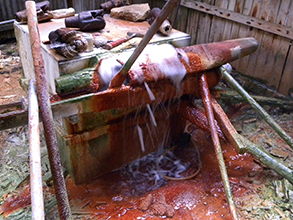

Figure. (Left) Iron oxide found in the source of Shionoha Hot Spring, Nara Prefecture. (Right) Measurement of Fe(II) concentration near the surface of the iron oxide using a microelectrode.
The causes of differences in microbialite fabrics are elucidated
[Key points of this research]
- It was found that the extracellular polymeric substances of cyanobacteria cause differences in the microbialite fabrics.
- It is possible that an event occurred before the Cambrian explosion that caused a major change in the composition of cyanobacterial communities.
[Overview]
Rocks formed by microorganisms are frequently found in the geological record and are called microbialites. Microbialites include stromatolites, which exhibit laminated fabric, and thrombolites, which exhibit clotted fabric. Thrombolites are known to have suddenly become abundant at the Proterozoic-Phanerozoic boundary (approximately 540 million years ago).
Based on research into modern stromatolites and thrombolites, our research group has clarified that differences in microbialite bacrics are caused by cyanobacterial communities with different EPS properties. It is possible that an event occurred at the Proterozoic-Phanerozoic boundary that significantly changed the composition of cyanobacterial communities. This may provide new insights into the Cambrian explosion and the preceding extinction of the Ediacaran fauna.
This research was conducted as the graduation and master's thesis of Mr. Yusaku Hanzawa (graduated in 2014), and the results were published in "Scientific Reports", an online scientific journal published by the Nature Publishing Group.
